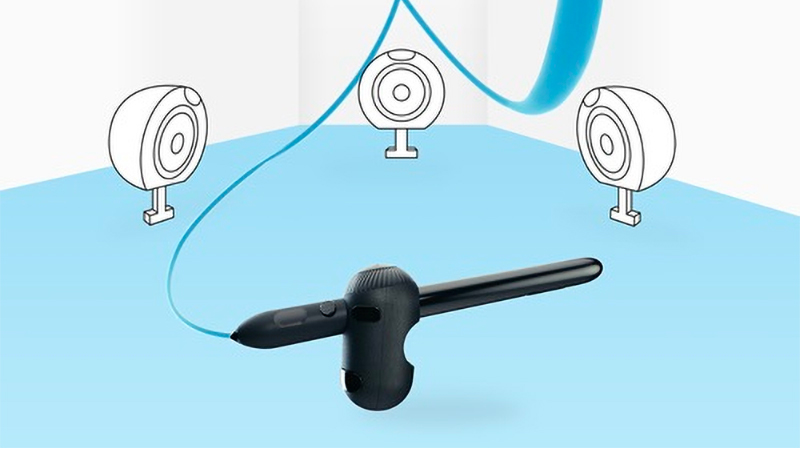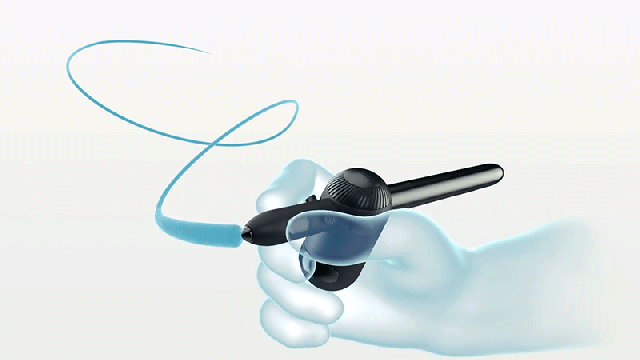One of the more practical uses for virtual reality is product design, allowing engineers and artists to create, refine, and perfect something in 3D instead of spending the money to iterate real-life prototypes. Wacom, a company synonymous with art and design, has created a new version of its stylus that offers functions like pressure sensitivity, which normally require a tablet, that can be activated in mid-air inside a VR environment.
It’s been slow to catch on as an entertainment tool for consumers, but virtual reality has long been in use by companies creating large and expensive items (think cars, planes, etc.) where designers can benefit from being able to walk around a 3D model and study it from different angles, even if the prototype only exists inside a computer. Known for its industry standard design tools, Wacom has long been researching ways to adapt its tablet and stylus technology, optimised for working in 2D, into a tool that allows artists and designers to use the same techniques inside a 3D environment.
[referenced id=”1145131″ url=”https://gizmodo.com.au/2019/01/wacom-showed-me-the-first-good-reason-to-buy-the-magic-leap-hype/” thumb=”https://gizmodo.com.au/wp-content/uploads/2019/01/12/vd7ndubhqjz5eojirll4.jpg” title=”Wacom Showed Me The First Good Reason To Buy The Magic Leap Hype” excerpt=”Fields as diverse as video game development, visual effects, and industrial design all rely on 3D software, but the tools used to make it remain firmly stuck in two-dimensions. For the past few years, Magic Leap’s mixed reality goggles have been heralded as the missing link between the digital 3D…”]
At CES 2019 we got a demo of Wacom’s work with Magic Leap to help leverage that VR hardware as a serious design tool, but there were some quirks to the workflow because it required the user to hold both a traditional Wacom stylus and one of the company’s drawing tablets in order to manipulate 3D objects floating in mid-air. It was neat, but awkward, and a demonstration of how Wacom’s technology needed to advance for VR. Two years later, Wacom has revealed its new VR Pen with some serious upgrades to the company’s traditional 2D stylii.
The company hasn’t revealed all the details about its Wacom VR Pen yet. Ahead of it being available to consumers, Wacom is teasing the hardware to encourage software developers to reach out so when the pen does go on sale, it will be well supported on the software side and not just a neat piece of hardware that doesn’t have many practical uses out of the box.
Looking like a traditional Wacom stylus that’s been stabbed through a wobbly desk toy, the Wacom VR Pen works with the company’s drawing tablets but will continue to detect strokes when lifted off a desk and used in mid-air. Instead of a built-in gyroscope for detecting motion, however, the Wacom VR Pen uses its own custom tracking system the company hasn’t released specs on just yet (such as how many sensors will be needed in a room) but promises the system will work with the most popular head-mounted VR displays.

One of the benefits to using a tablet is that Wacom not only incorporates customisable shortcut buttons so artists aren’t always reaching for a computer keyboard, it also facilitates pressure sensitivity, so by pressing harder with a stylus artists can create thicker strokes or apply other effects on the fly. On the Wacom VR Pen, pressure sensitivity is instead facilitated into the tip, so instead of pressing harder on a surface, users squeeze the tip of the stylus with varying degrees of force to affect their strokes. A large scroll wheel with a centre mounted button has also been incorporated into the VR Pen’s bulge, allowing quick access to tools and settings without having to leave a virtual reality environment.
One thing Wacom hasn’t revealed is whether or not the new VR Pen will need to be charged, but given that the company’s traditional stylii need to be in a certain proximity to Wacom’s powered tablets in order to function, the new VR version is probably packing an onboard battery so it can be used in mid-air without wires.
